Windows 11 All-in-One For Dummies. Ciprian Adrian Rusen
Читать онлайн.| Название | Windows 11 All-in-One For Dummies |
|---|---|
| Автор произведения | Ciprian Adrian Rusen |
| Жанр | Зарубежная компьютерная литература |
| Серия | |
| Издательство | Зарубежная компьютерная литература |
| Год выпуска | 0 |
| isbn | 9781119858713 |
FIGURE 3-10: Editing the list of quick actions.
TABLE 3-1 Quick Actions and What They Do
| Click or Tap This Icon | And This Happens |
|---|---|
| Accessibility | Turns on or off different accessibility tools such as Magnifier, Color Filters, Narrator, Mono Audio, and Sticky Keys. |
| Airplane mode | Turns all wireless communication on and off. See the Settings app’s Network & Internet, Airplane Mode setting. |
| Battery saver | Cycles between two battery saver modes, dimming the display. It doesn’t work if the laptop or tablet is plugged in. |
| Bluetooth | Turns Bluetooth on or off. |
| Brightness | Adjusts the screen brightness to the level you want. |
| Cast | Searches for wireless display and audio devices to project to — Miracast in particular. |
| Focus assist | Turns focus assist on or off. When turned on, all notifications are blocked. |
| Keyboard layout | Switches between multiple keyboard languages or layouts. |
| Project | Projects the image on your screen to an external display or a projector. |
| Rotation lock | Prevents the screen from rotating from portrait to landscape and vice versa. |
| Volume | Adjusts the screen's sound volume to the level you want. |
Chapter 4
Managing User Accounts
IN THIS CHAPTER
Most Windows PCs have just one user account. Although many PCs are each used by just one person, I think it’s highly likely that people don’t set up multiple user accounts on their PCs because they’re intimidated. Not to worry. I take you through the ins and outs of this process.
Even if you’re the only person who ever uses your PC, you may want to create a second account — another user, as it were — even if the second user is just you. Then again, you may not. And therein lies this chapter’s story.
If you’re running Windows 11 Enterprise or Windows 11 Pro and your PC is connected to a big corporate network (a domain), you have little or no control over who can log in to your computer and what logged-in users can do after they're on the machine. That’s a Good Thing, at least in theory: Your company’s network administrator gets to worry about all the security issues, relieving you of the hassles of figuring out whether the co-worker down the hall should be able to look at payroll records or the company Christmas card list. But it can also be a pain in the neck, especially if you have to install a program, like, right now, and you don’t have a user account with sufficient capabilities. If your computer is attached to a domain, an administrator might install the program for you. This chapter applies only to PCs connected to small networks or to stand-alone PCs.
First, I present the types of Windows 11 accounts: standard accounts, administrator accounts, local account, and Microsoft accounts. You see know how they differ and how they mix with each other. I also show you how to add any account you want, including a special type called the child account, which is useful for families with children. Lastly, you see how to edit other user accounts from an administrator account and how to switch between accounts.
Here’s hoping that this list of topics doesn’t seem too long or intimidating.
Understanding Why You Need Separate User Accounts
All sorts of problems crop up when several people share a PC. You may have set up your desktop just right, with all your shortcuts right where you can find them, and then your significant other comes along and changes the wallpaper, accidentally deletes some files you may need, and adds their own apps and shortcuts on the desktop. It’s worse than sharing a TV remote.
Also, I’m sure you don’t want others to open Microsoft Edge and take a peek into your Facebook account or see all the recent videos you’ve played on your computer. To get around this issue, it's a good idea to create a separate user account for each individual using your computer.
Windows 11 helps keep peace in the family — and in the office — by requiring people to log in. The process of logging in (also called signing in) lets the operating system keep track of each person’s settings: You tell Windows 11 who you are, and it lets you play in your own sandbox.
Choosing Account Types
When dealing with user accounts, you bump into one existential fact of Windows life repeatedly: The type of account you use puts limitations on what you can do.
Unless your PC is hooked up to a big corporate network, user accounts can generally be divided into two groups: the haves and the have-nots. (Users attached to corporate domains are assigned accounts that can exist anywhere on the have-to-have-not spectrum.) The have accounts are administrator accounts. The have-nots are standard accounts.
What’s a standard account?
If you're running
